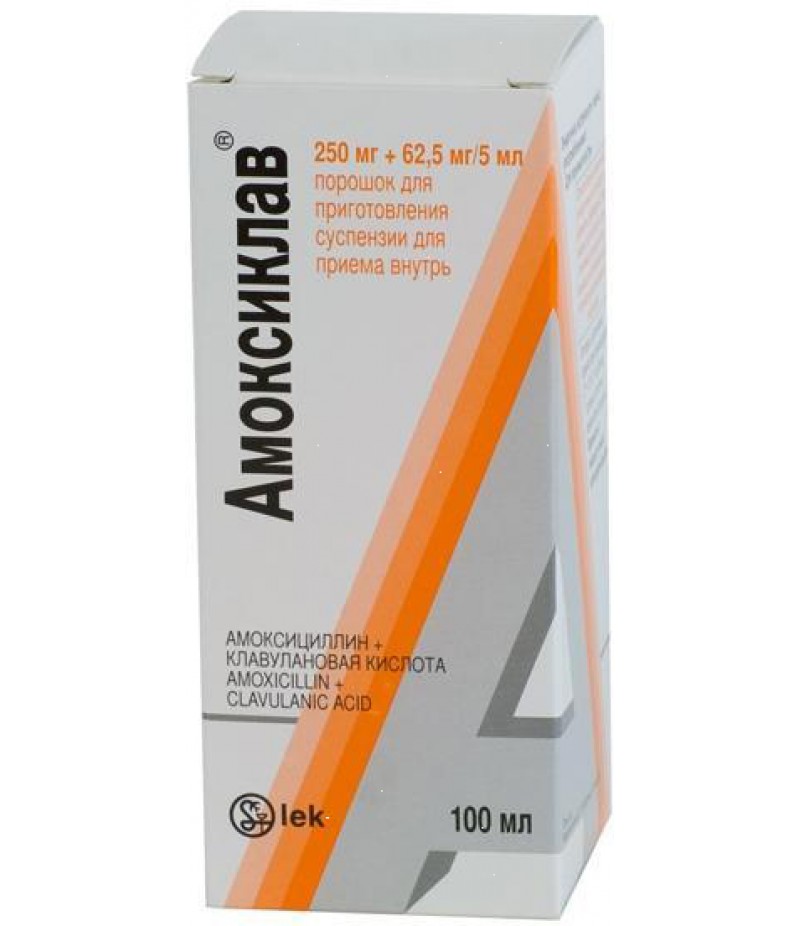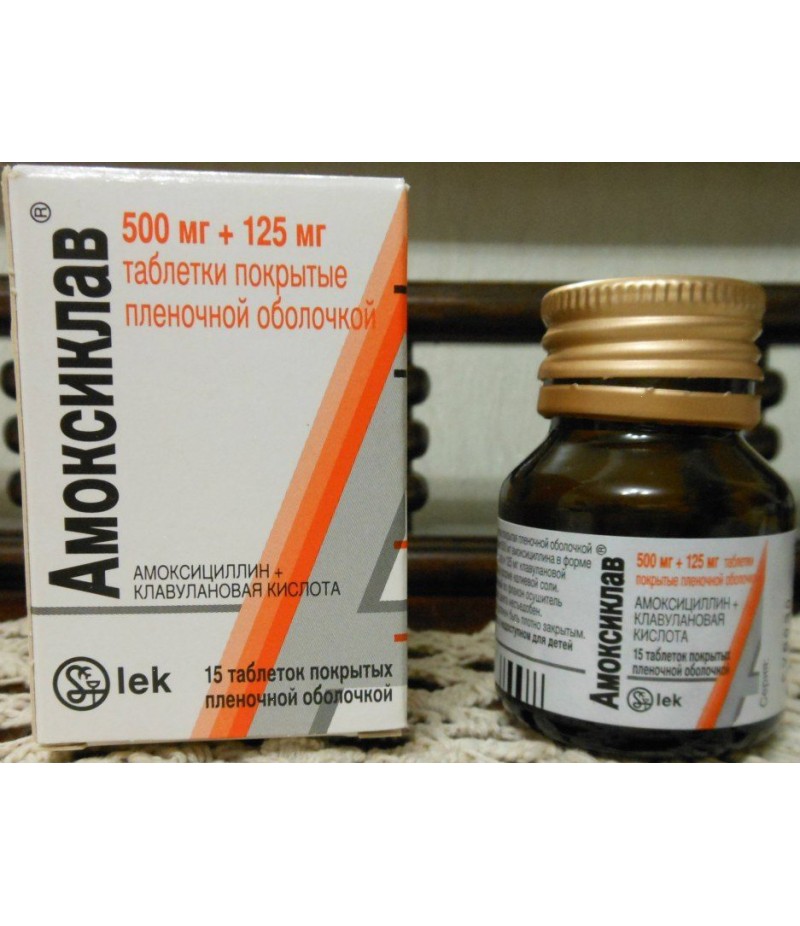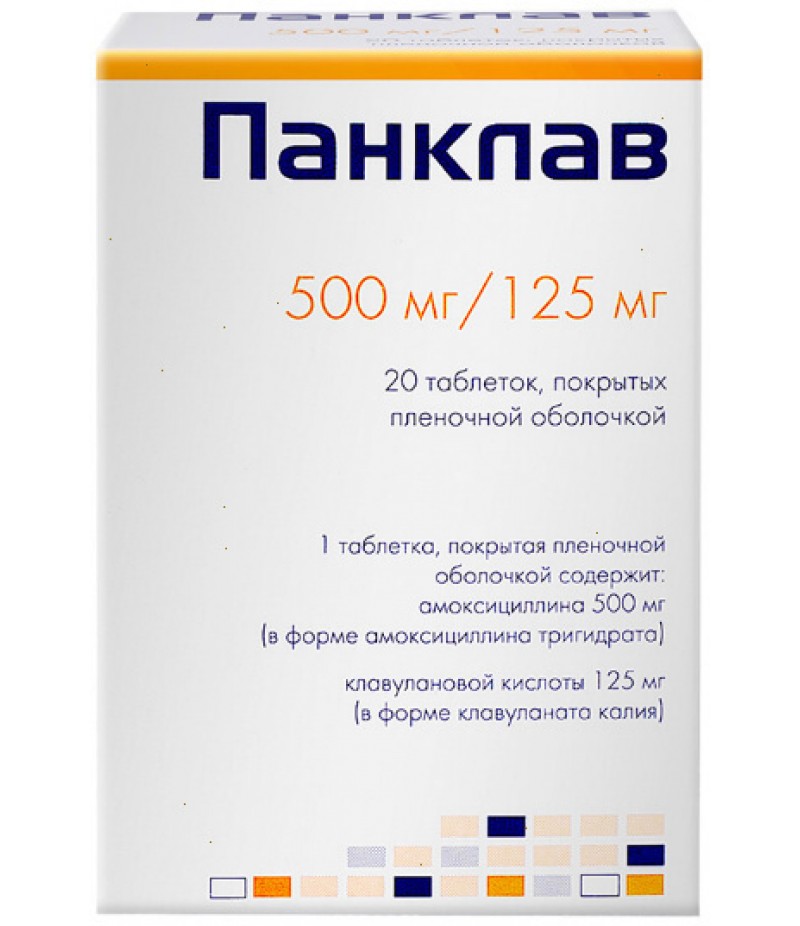Amoksiklav powder 250mg + 62.5mg / 5ml 25gr 20 doses
- $16.63
- 3 or more $15.90
- Availability:In Stock
Buy Amoksiklav powder onlineInstruction for Amoksiklav powderForm of release, composition and packagingPowder for the preparation of a suspension for ingestion from white to yellowish white; the prepared suspension is homogeneous,..
Tags: powder
Buy Amoksiklav powder online
Instruction for Amoksiklav powder
Form of release, composition and packaging
Powder for the preparation of a suspension for ingestion from white to yellowish white; the prepared suspension is homogeneous, from almost white to yellowish color.
amoxicillin (in the form of trihydrate) 250 mg
clavulanic acid (in the form of a potassium salt) 62.5 mg
Auxiliary substances: citric acid anhydrous, sodium citrate anhydrous, sodium benzoate, microcrystalline cellulose, sodium carmellose, xanthan gum, silicon dioxide colloid, silicon dioxide, sodium saccharinate, mannitol, flavorings (strawberry, wild cherry, lemon).
25 g - bottles of dark glass with a volume of 100 ml (1) complete with a dosage spoon / pipette - packs of cardboard.
pharmachologic effect
Amoxiclav is a combination of amoxicillin, a semisynthetic penicillin with a broad spectrum of antibacterial activity and clavulanic acid, an irreversible inhibitor of β-lactamases. Clavulanic acid forms a stable inactivated complex with these enzymes and provides stability of amoxicillin to the action of β-lactamases produced by microorganisms.
Clavulanic acid, similar in structure to beta-lactam antibiotics, has a weak intrinsic antibacterial activity.
Amoxiclav has a broad spectrum of antibacterial action.
It is active against amoxicillin-sensitive strains, including strains producing β-lactamases, incl. aerobic Gram-positive bacteria: Streptococcus pneumoniae, Streptococcus pyogenes, Streptococcus viridans, Streptococcus bovis, Staphylococcus aureus (except methicillin-resistant strains), Staphylococcus epidermidis (except methicillin-resistant strains), Staphylococcus saprophyticus, Listeria spp., Enterococcus spp .; aerobic gram-negative bacteria: Bordetella pertussis, Brucella spp., Campylobacter jejuni, Escherichia coli, Gardnerella vaginalis, Haemophilus influenzae, Haemophilus ducreyi, Klebsiella spp., Moraxella catarrhalis, Neisseria gonorrhoeae, Neisseria meningitidis, Pasteurella multocida, Proteus spp., Salmonella spp. Shigella spp., Vibrio cholerae, Yersinia enterocolitica, Helicobacter pylori, Eikenella corrodens; anaerobic Gram-positive bacteria: Peptococcus spp., Peptostreptococcus spp., Clostridium spp., Actinomyces israelii, Fusobacterium spp., Prevotella spp., Gram-negative anaerobes: Bacteroides spp.
Pharmacokinetics
The main pharmacokinetic parameters of amoxicillin and clavulanic acid are similar.
Suction
Both components are well absorbed after taking the drug inside, eating does not affect the degree of absorption. Cmax in blood plasma is achieved 1 h after administration. The Cmax values for amoxicillin (depending on the dose) are 3-12 μg / ml, for clavulanic acid - about 2 μg / ml.
Distribution
Both components are characterized by a good distribution in the fluids and tissues of the body (lungs, middle ear, pleural and peritoneal fluids, uterus, ovaries, etc.). Amoxicillin also penetrates into the synovial fluid, liver, prostate, palatine tonsils, muscle tissue, gall bladder, the secret of the paranasal sinuses, saliva, bronchial secretions.
Amoxicillin and clavulanic acid do not penetrate the BBB in non-inflamed meninges.
Amoxicillin and clavulanic acid penetrate the placental barrier and in trace concentrations are excreted in breast milk. Amoxicillin and clavulanic acid are characterized by low binding to plasma proteins.
Metabolism
Amoxicillin is partially metabolized, clavulanic acid undergoes, apparently, intensive metabolism.
Excretion
Amoxicillin is excreted by the kidneys practically unchanged through tubular secretion and glomerular filtration. Clavulanic acid is excreted by glomerular filtration, partly in the form of metabolites. Small amounts can be excreted through the intestines and lungs. T1 / 2 amoxicillin and clavulanic acid is 1-1.5 h.
Pharmacokinetics in special clinical cases
In severe renal failure, T1 / 2 increases to 7.5 h for amoxicillin and up to 4.5 h for clavulanic acid. Both components are removed by hemodialysis and minor amounts of peritoneal dialysis.
Indications
Infections caused by sensitive strains of microorganisms:
- infections of the upper respiratory tract and ENT organs (including acute and chronic sinusitis, acute and chronic otitis media, zaglugal abscess, tonsillitis, pharyngitis);
- infections of the lower respiratory tract (including acute bronchitis with bacterial superinfection, chronic bronchitis, pneumonia);
- urinary tract infections;
- gynecological infections;
- skin and soft tissue infections, including animal and human bites;
- infections of bone and connective tissue;
- biliary tract infections (cholecystitis, cholangitis);
Odontogenic infections.
Dosing regimen
Inside.
Daily dosage of suspensions 125 mg + 31.25 mg / 5 ml and 250 mg + 62.5 mg / 5 ml (to facilitate correct dosing in each package of suspensions 125 mg + 31.25 mg / 5 ml and 250 mg + 62.5 mg / 5 ml a dosage spoon with a capacity 5 ml or a metered graduated pipette).
Newborns and children under 3 months are prescribed 30 mg / kg (amoxicillin) / day, divided into 2 divided doses (every 12 hours); children older than 3 months - from 20 mg (amoxicillin) / kg / day for infections of mild to moderate severity up to 40 mg / kg (amoxicillin) / day for severe infection and respiratory tract infections, divided into 3 doses (every 8 h).
Rules for the preparation of suspension
Powder for the preparation of a suspension of 250 mg + 62.5 mg / 5 ml: vigorously shake the bottle, add 85 ml of water (up to the mark) in two steps, each time shaking well until the powder is completely dissolved.
Before use, the vial should be vigorously shaken.
Side effect
Side effects in most cases are mild and transitory.
On the part of the digestive system: loss of appetite, nausea, vomiting, diarrhea; rarely - abdominal pain, liver dysfunction, increased activity of liver enzymes (ALT or AST); in isolated cases - cholestatic jaundice, hepatitis, pseudomembranous colitis.
Allergic reactions: itching, urticaria, erythematous rash; rarely - multi-form exudative erythema, angioedema, anaphylactic shock, allergic vasculitis; in isolated cases - exfoliative dermatitis, Stevens-Johnson syndrome, acute generalized exanthematous pustulosis.
From the hemopoietic system and lymphatic system: rarely - reversible leukopenia (including neutropenia), thrombocytopenia; very rarely - hemolytic anemia, reversible increase in prothrombin time (when combined with anticoagulants), eosinophilia, pancytopenia.
From the nervous system: dizziness, headache; very rarely - convulsions (may occur in patients with impaired renal function when taking the drug in high doses), hyperactivity, anxiety, insomnia.
From the side of the urinary system: very rarely - interstitial nephritis, crystalluria.
Other: rarely - development of superinfection (including candidiasis).
Contraindications
- hypersensitivity to any of the components of the drug;
- heightened sensitivity in the anamnesis to penicillins, cephalosporins and other beta-lactam antibiotics;
- the presence in the anamnesis of indications of cholestatic jaundice and / or other violations of the liver caused by the use of amoxicillin / clavulanic acid;
- infectious mononucleosis and lymphocytic leukemia.
With caution should be used with pseudomembranous colitis in history, with liver failure, severe impairment of kidney function, and also during lactation.
Application in pregnancy and lactation
Amoksiklav it is possible to appoint or nominate at pregnancy at presence of accurate indications.
Amoxicillin and clavulanic acid in small amounts are excreted in breast milk.
special instructions
With the course of treatment should monitor the functions of the organs of hematopoiesis, liver and kidneys.
Patients with severe impairment of renal function require adequate correction of the dosing regimen or an increase in the intervals between dosing.
To reduce the risk of adverse reactions from the gastrointestinal tract, you should take the drug while eating.
Laboratory tests: high concentrations of amoxicillin give a false positive reaction to urine glucose when using a Benedict reagent or Felling solution. It is recommended to use enzymatic reactions with glucosidase.
Impact on the ability to drive vehicles and manage mechanisms
Data on the adverse effects of Amoxiclav in the recommended doses on the ability to drive or work with machines are not.
Overdose
There are no reports of death or the occurrence of life-threatening side effects due to an overdose of the drug.
Symptoms: in most cases - disorders of the gastrointestinal tract (abdominal pain, diarrhea, vomiting), possibly also anxiety, insomnia, dizziness; in isolated cases - convulsive seizures.
Treatment: the patient must be under medical supervision; symptomatic therapy. In the case of the recent administration of the drug (less than 4 hours), it is necessary to perform gastric lavage and prescribe activated charcoal to reduce absorption of the drug. Amoxicillin / potassium clavunate is removed by hemodialysis.
Drug Interactions
With the simultaneous use of the drug Amoxiclav with antacids, glucosamine, laxatives, aminoglycosides, absorption slows down, with ascorbic acid - increases.
Diuretics, allopurinol, phenylbutazone, NSAIDs and other drugs that block tubular secretion, increase the concentration of amoxicillin (clavulanic acid is excreted mainly by glomerular filtration).
With the simultaneous use of Amoxiclav increases the toxicity of methotrexate.
With simultaneous application of Amoxiclav with allopurinol, the frequency of development of exanthema increases.
Simultaneous administration with disulfiram should be avoided.
In some cases, taking the drug may prolong prothrombin time, therefore caution should be exercised while concomitant administration of anticoagulants and Amoxiclav preparation.
The combination of amoxicillin and rifampicin is antagonistic (there is a mutual weakening of antibacterial action).
Amoxiclav should not be used concomitantly with bacteriostatic antibiotics (macrolides, tetracyclines), sulfonamides due to a possible decrease in the effectiveness of Amoxiclav.
Probenecid reduces the excretion of amoxicillin, increasing its serum concentration.
Antibiotics reduce the effectiveness of oral contraceptives.
Terms and conditions of storage
The drug should be stored in a dry place inaccessible to children at a temperature of no higher than 25 ° C. Shelf life - 2 years.
After preparation, the suspension for oral administration should be stored at a temperature of 2 ° to 8 ° C in a tightly closed vial and used within 7 days.



